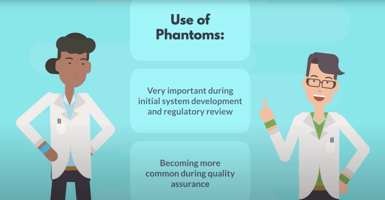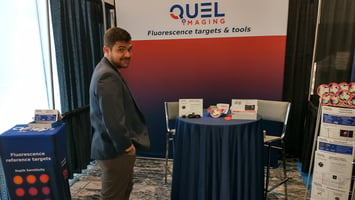Fluorescence-guided surgery (FGS) gives surgeons enhanced precision by illuminating specific...
Our analysis of the ARPA-H PSI program
I wrote the following summary after attending the ARPA-H kick-off meeting in Chicago on September 7th. The day was filled with opportunities to network and I was able to speak with a number of our current customers and collaborators. The information in this post are my own opinions and observations. Please refer to the full details of the ARPA-H PSI program and the BAA for more information
PSI Focus Areas:
All require end-to-end solutions that does not add more than 10 minutes of OR time
TA1-A (in vitro pathology): intraoperative microscopic imaging of a resected specimen with automatic classification of 10 x 10 x 10 cm volume. Staining can be done, but only after removal. 2+ cancer indications (Ranked preference for first cancer type: breast, colorectal, head and neck, ovarian)
TA1-B (in vivo pathology): intraoperative microscopic imaging of resection cavity and automatic classification. With or without contrast agent specific to tumor microenvironment. 2+ cancer indications (Ranked preference for first cancer type: prostate, breast, ovarian)
TA2 (Healthy structure localization): Development of devices to localize structures of interest at depth with or without contrast agents. 0.5 mm resolution up to 2 mm depth, to 2 mm resolution at 5-10 mm depth. Demonstrate in two types of surgeries (i.e.: thoracotomies, mastectomies, prostate cancer removal, or orthopedics)
Only one Focus Area can be chosen, with the exception of proposals that combine TA1-B and TA2.
Timeline
Abstracts due (4 page max): September 21st, Noon (Eastern)
Full Proposal due: November 16th, 5PM (Eastern)
Funding decision: (estimated) February 2024
Assessment of ARPA-H PSI program
The PSI program has very ambitious milestones spread over a 5 year period. Their funding structure is also unique in a few ways. First, the timeline from application to award is extremely short (Abstracts in September, Full proposal in November, Decision by January/February). The award period is two phases over 5 years, with regular milestone check-ins. The first phase is over two years, followed by a three year phase. Unlike the SBIR program, the call for proposals is not limited to small businesses, but the PI must be US-based. There is also more of an emphasis on clinical translation. So, while the proposal says a university can apply, in my opinion, it seems a professor acting as PI would need to put their academic career on hold for 5 years while overseeing the project. I say this because ARPA-H is more interested in creating a clinical impact, than academic publications. Publications will still be possible and expected, but the project will need to be run more like a fast-growing business to be clinically successful. Universities or academic hospitals generally do not have their administrative support organized to be nimble and accelerate clinical translation. For this reason, it seems like a company, or non-academic entity should employ the PI during this period.
The expected budget is somewhat nebulous. This analysis is solely based on a comparison with the SBIR program, and not on any specific budgeting related to technical developments. I just wanted to do a thought-exercise to estimate the order of magnitude that could be expected for this project. As a comparison to a NIH SBIR contract, the Phase 1 budget is generally capped at $400K over 9 months, however there is no cap for the ARPA-H program. They want teams to be realistic and justify their costs, but obviously not greedy. Since the teams will need to be larger to begin with, it seems like a 1st year budget of $750-$1.5M would be reasonable, and then increase each year as the project gets more complex and clinical trials begin. As a rough estimate this cost breakdown could be in the following range (although it will vary drastically based on the team size and qualifications):
- Year 1: $0.75M - $1.5M
- Year 2: $1.25 - $3M
- Year 3: $2M - $4M
- Year 4: $3M - $6M
- Year 5: $4M - $8M
- Total: $11 - 22.5M
Having worked with a number of academic and industry partners, it seems as though a large industry partner would be extremely beneficial in catalyzing the R&D and preparing for clinical adoption. A small academic team is not well suited for this task. At the same time, the condensed timeline introduces difficulties for larger companies and probe developers, as they tend to be very protective of IP and potentially litigious, yet have the teams and resources to see this project through. A small nimble company could see this project through, but would need more guidance from experienced organizations. ARPA-H is organized to help reduce barriers, so a nimble team may be the way to go, although there is the added risk of in-experience with the regulatory process.
How does QUEL Imaging fit in?
This initiative has very demanding milestones over a tight timeline. By partnering with a team early, we can focus on developing quality phantoms that provide quantitative metrics of system performance. Using the flexibility of our manufacturing process, and knowledge of tissue optical properties, we can develop customized reference targets for early stage testing. These targets are ideal for accelerating the R&D lifecycle. This allows the PI and system or probe development team to focus on their priorities, and not waste valuable time making serial dilutions or designing ad hoc characterization solutions. The scalability of the QUEL Imaging manufacturing process also provides a method for distributed teams to test system components and compare results. The high-quality quantitative metrics should reduce the burden of the FDA regulatory process and may reduce the reliance on expensive and time-consuming animal models. While animal and human studies will be needed, solutions like the QUEL Imaging radiometric target can also be utilized to provide a stable reference between study time points or multi-center comparisons. Through customer conversations, we’ve estimated our phantoms save approximately 20% of a developer’s time during R&D. We’ve also had customer reporting positive experiences with the FDA when using our phantoms to report system characterization metrics. Our analysis expertise, and potential to develop digital twins is an added benefit to any team pursuing this funding mechanism. Through an on-going partnership, QUEL Imaging can support the entire life cycle from R&D through manufacturing and post-clearance marketing. We aim to accelerate clinical adoption by leveraging our deep technical knowledge and customization manufacturing procedures.
The estimated cost of a QUEL Imaging collaboration would be in the range of 10-15% of the yearly budget, but could be scaled up or down based on the complexity of the project and whether a customized contrast agent is used, or other development is needed. Examples of development activities could range from expanding our phantoms to have additional bio-mimicking properties, incorporate new contrast mechanisms, or test specific milestones. Over the next 2 years QUEL Imaging will be using SBIR funds to drastically expand our existing manufacturing capability to utilize more NIR fluorophores, develop tumor resection models, demonstrate dynamic flow networks and incorporate non-rigid phantoms into our product line-up. This development is timed in such a manner that knowledge gained through these activities could be leveraged to reduce the overall cost of collaborations.
If you would like to discuss the possibility of collaborations for the ARPA-H PSI program, or for any other reason, please schedule a call.




